Nursing Skill Mix in Contemporary Healthcare: Challenges and Impact
VerifiedAdded on 2023/04/04
|11
|2662
|292
Essay
AI Summary
This essay delves into the complexities of nursing skill mix in contemporary healthcare, examining the challenges and their impact on patient care. The introduction highlights the importance of translational medicine and community health in modern healthcare, emphasizing the role of nursing in patient handling and clinical reasoning. The discussion section defines nursing skill mix, explores the impact of nursing shortages, and analyzes the optimal ratio of registered nurses to other healthcare professionals. It also considers the role of Assistants in Nursing (AINs) and their impact on skill mix, including how it affects nurses and patient outcomes. The essay further examines the challenges of implementing skill mix strategies, such as cost-effectiveness and transparency goals, and emphasizes the importance of patient satisfaction. It also explores the relationship between staffing levels, skill mix, and patient outcomes, providing insights into factors that influence the quality of care. The conclusion synthesizes these points, offering a comprehensive overview of the challenges and potential solutions related to nursing skill mix in contemporary healthcare, providing a valuable resource for nursing students and professionals alike.
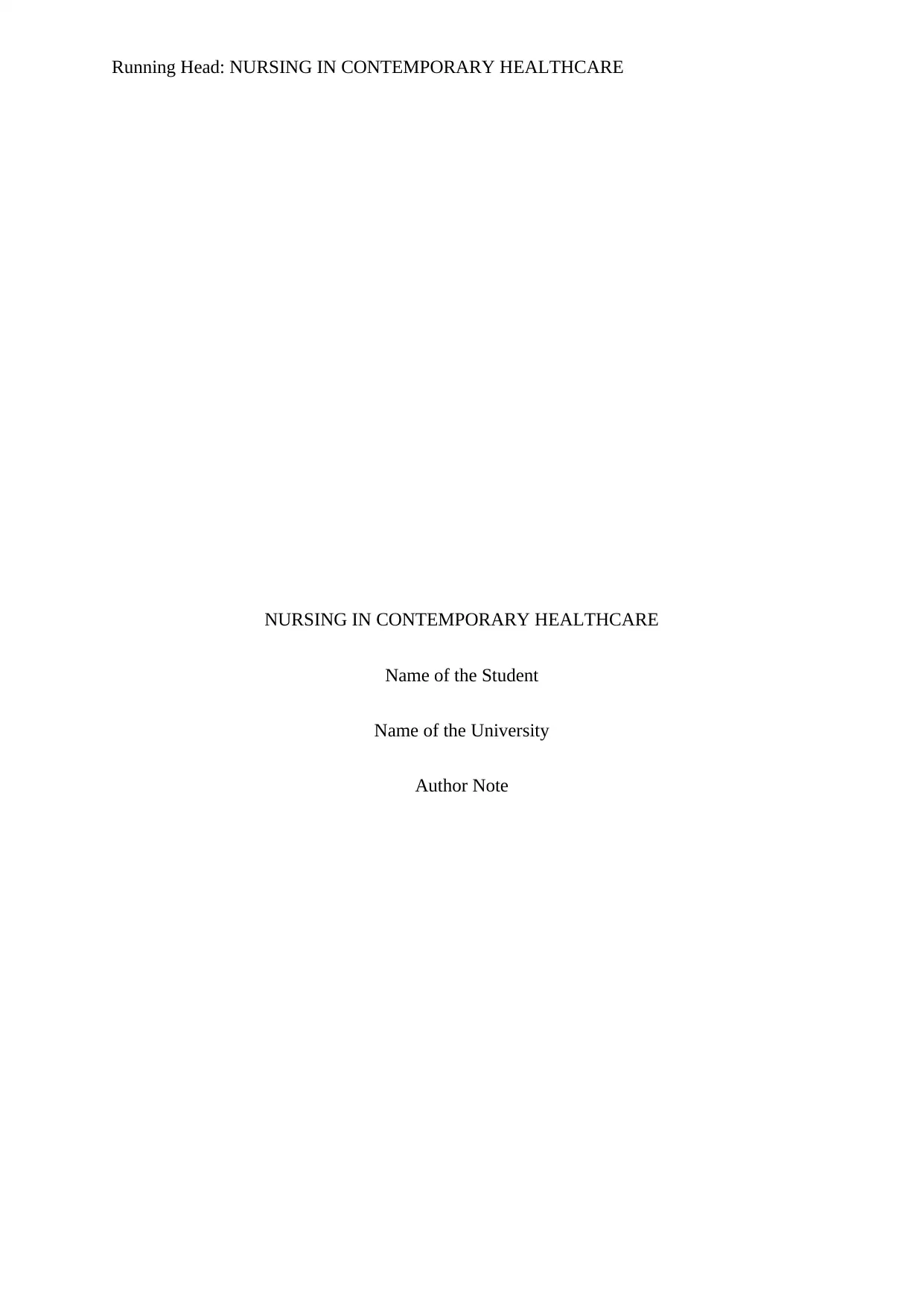
Running Head: NURSING IN CONTEMPORARY HEALTHCARE
NURSING IN CONTEMPORARY HEALTHCARE
Name of the Student
Name of the University
Author Note
NURSING IN CONTEMPORARY HEALTHCARE
Name of the Student
Name of the University
Author Note
Paraphrase This Document
Need a fresh take? Get an instant paraphrase of this document with our AI Paraphraser
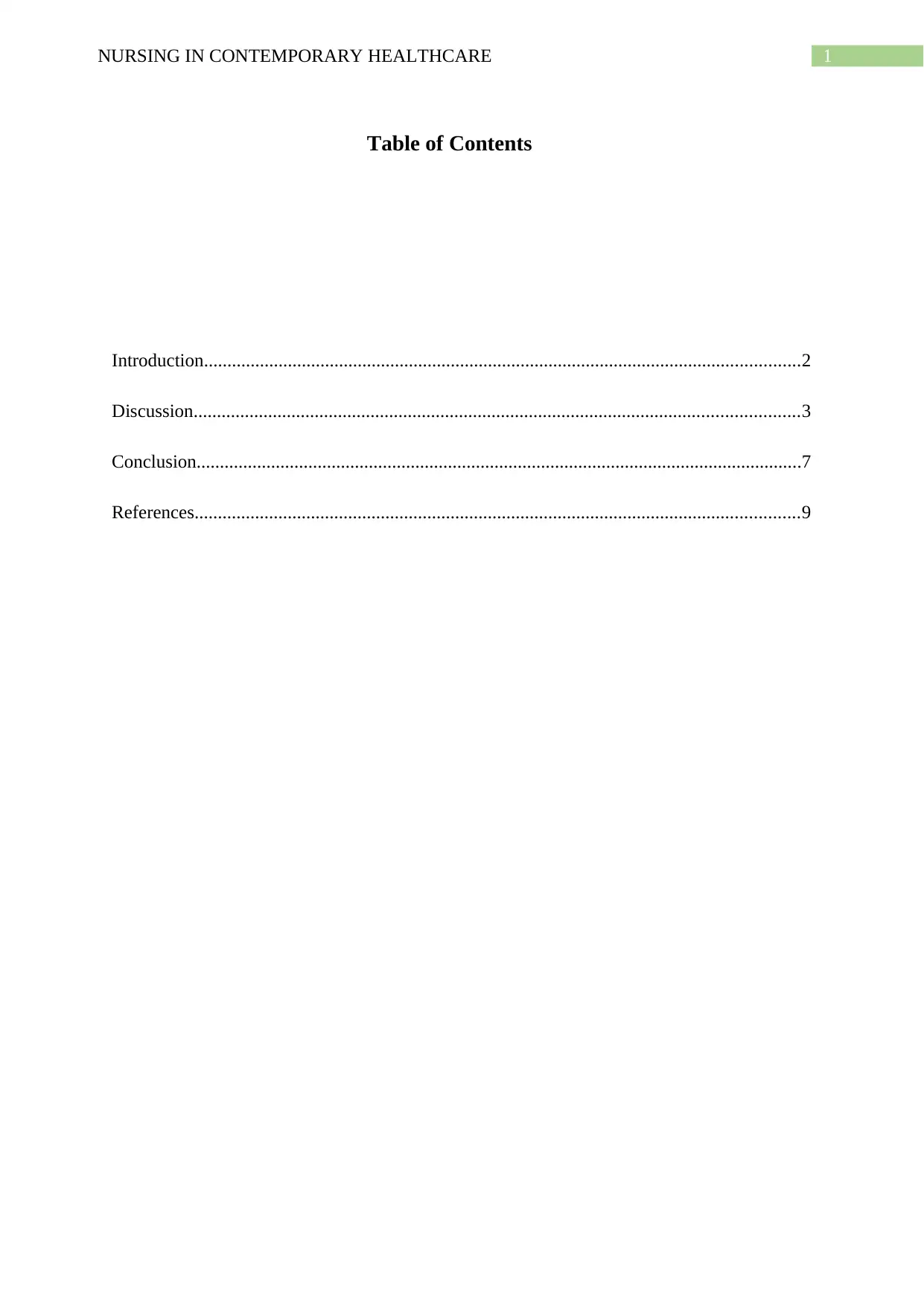
1NURSING IN CONTEMPORARY HEALTHCARE
Table of Contents
Introduction................................................................................................................................2
Discussion..................................................................................................................................3
Conclusion..................................................................................................................................7
References..................................................................................................................................9
Table of Contents
Introduction................................................................................................................................2
Discussion..................................................................................................................................3
Conclusion..................................................................................................................................7
References..................................................................................................................................9
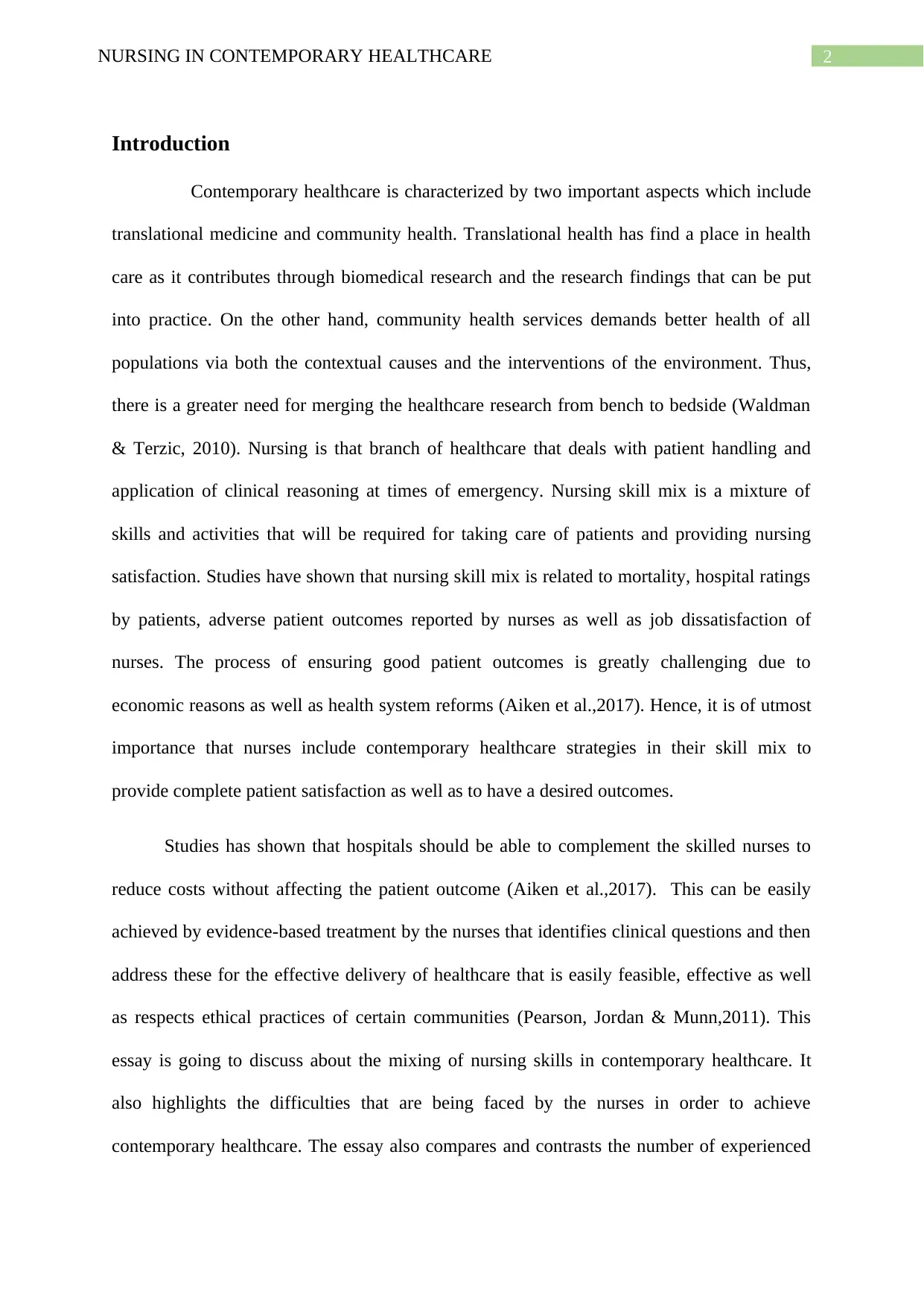
2NURSING IN CONTEMPORARY HEALTHCARE
Introduction
Contemporary healthcare is characterized by two important aspects which include
translational medicine and community health. Translational health has find a place in health
care as it contributes through biomedical research and the research findings that can be put
into practice. On the other hand, community health services demands better health of all
populations via both the contextual causes and the interventions of the environment. Thus,
there is a greater need for merging the healthcare research from bench to bedside (Waldman
& Terzic, 2010). Nursing is that branch of healthcare that deals with patient handling and
application of clinical reasoning at times of emergency. Nursing skill mix is a mixture of
skills and activities that will be required for taking care of patients and providing nursing
satisfaction. Studies have shown that nursing skill mix is related to mortality, hospital ratings
by patients, adverse patient outcomes reported by nurses as well as job dissatisfaction of
nurses. The process of ensuring good patient outcomes is greatly challenging due to
economic reasons as well as health system reforms (Aiken et al.,2017). Hence, it is of utmost
importance that nurses include contemporary healthcare strategies in their skill mix to
provide complete patient satisfaction as well as to have a desired outcomes.
Studies has shown that hospitals should be able to complement the skilled nurses to
reduce costs without affecting the patient outcome (Aiken et al.,2017). This can be easily
achieved by evidence-based treatment by the nurses that identifies clinical questions and then
address these for the effective delivery of healthcare that is easily feasible, effective as well
as respects ethical practices of certain communities (Pearson, Jordan & Munn,2011). This
essay is going to discuss about the mixing of nursing skills in contemporary healthcare. It
also highlights the difficulties that are being faced by the nurses in order to achieve
contemporary healthcare. The essay also compares and contrasts the number of experienced
Introduction
Contemporary healthcare is characterized by two important aspects which include
translational medicine and community health. Translational health has find a place in health
care as it contributes through biomedical research and the research findings that can be put
into practice. On the other hand, community health services demands better health of all
populations via both the contextual causes and the interventions of the environment. Thus,
there is a greater need for merging the healthcare research from bench to bedside (Waldman
& Terzic, 2010). Nursing is that branch of healthcare that deals with patient handling and
application of clinical reasoning at times of emergency. Nursing skill mix is a mixture of
skills and activities that will be required for taking care of patients and providing nursing
satisfaction. Studies have shown that nursing skill mix is related to mortality, hospital ratings
by patients, adverse patient outcomes reported by nurses as well as job dissatisfaction of
nurses. The process of ensuring good patient outcomes is greatly challenging due to
economic reasons as well as health system reforms (Aiken et al.,2017). Hence, it is of utmost
importance that nurses include contemporary healthcare strategies in their skill mix to
provide complete patient satisfaction as well as to have a desired outcomes.
Studies has shown that hospitals should be able to complement the skilled nurses to
reduce costs without affecting the patient outcome (Aiken et al.,2017). This can be easily
achieved by evidence-based treatment by the nurses that identifies clinical questions and then
address these for the effective delivery of healthcare that is easily feasible, effective as well
as respects ethical practices of certain communities (Pearson, Jordan & Munn,2011). This
essay is going to discuss about the mixing of nursing skills in contemporary healthcare. It
also highlights the difficulties that are being faced by the nurses in order to achieve
contemporary healthcare. The essay also compares and contrasts the number of experienced
⊘ This is a preview!⊘
Do you want full access?
Subscribe today to unlock all pages.

Trusted by 1+ million students worldwide
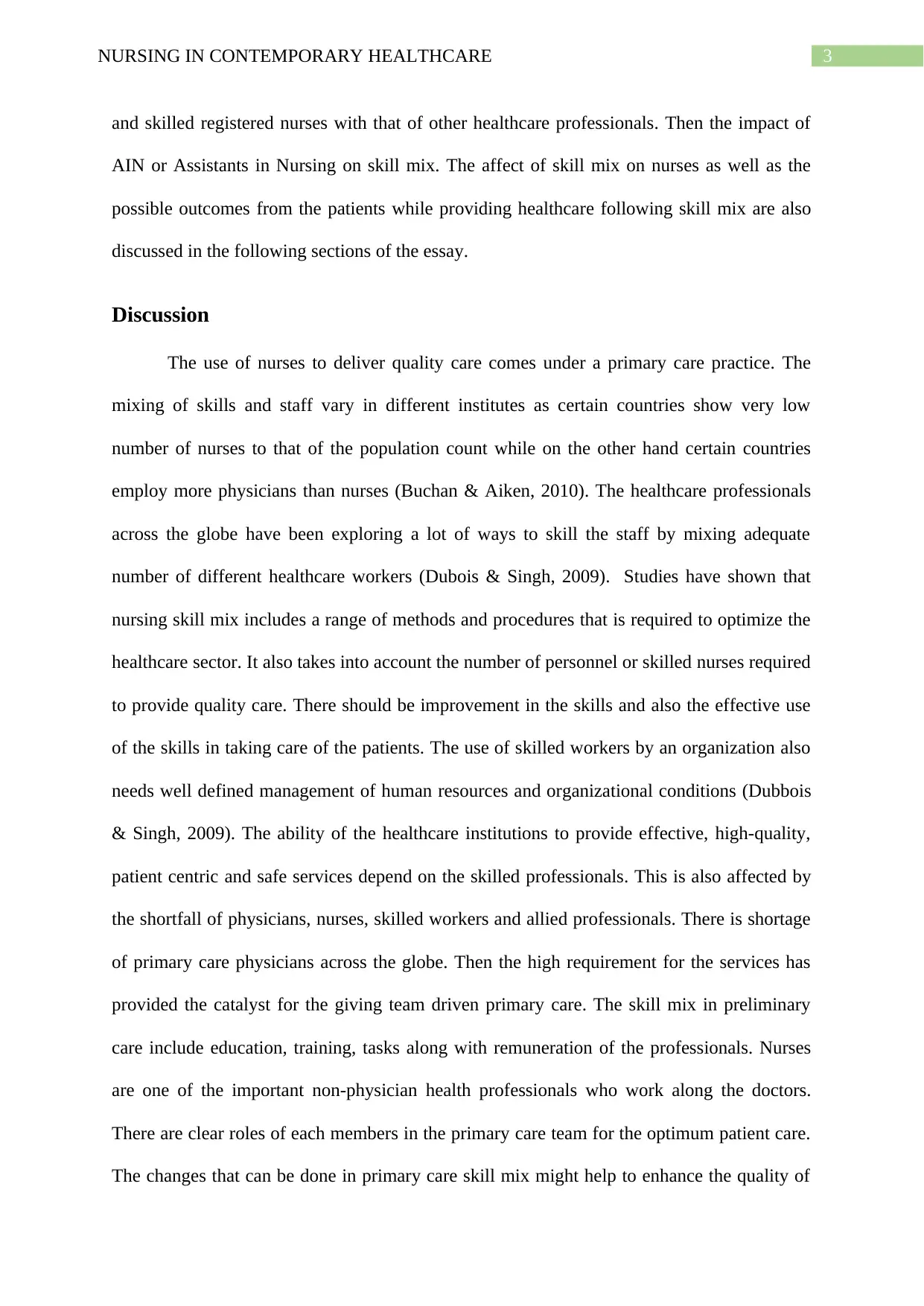
3NURSING IN CONTEMPORARY HEALTHCARE
and skilled registered nurses with that of other healthcare professionals. Then the impact of
AIN or Assistants in Nursing on skill mix. The affect of skill mix on nurses as well as the
possible outcomes from the patients while providing healthcare following skill mix are also
discussed in the following sections of the essay.
Discussion
The use of nurses to deliver quality care comes under a primary care practice. The
mixing of skills and staff vary in different institutes as certain countries show very low
number of nurses to that of the population count while on the other hand certain countries
employ more physicians than nurses (Buchan & Aiken, 2010). The healthcare professionals
across the globe have been exploring a lot of ways to skill the staff by mixing adequate
number of different healthcare workers (Dubois & Singh, 2009). Studies have shown that
nursing skill mix includes a range of methods and procedures that is required to optimize the
healthcare sector. It also takes into account the number of personnel or skilled nurses required
to provide quality care. There should be improvement in the skills and also the effective use
of the skills in taking care of the patients. The use of skilled workers by an organization also
needs well defined management of human resources and organizational conditions (Dubbois
& Singh, 2009). The ability of the healthcare institutions to provide effective, high-quality,
patient centric and safe services depend on the skilled professionals. This is also affected by
the shortfall of physicians, nurses, skilled workers and allied professionals. There is shortage
of primary care physicians across the globe. Then the high requirement for the services has
provided the catalyst for the giving team driven primary care. The skill mix in preliminary
care include education, training, tasks along with remuneration of the professionals. Nurses
are one of the important non-physician health professionals who work along the doctors.
There are clear roles of each members in the primary care team for the optimum patient care.
The changes that can be done in primary care skill mix might help to enhance the quality of
and skilled registered nurses with that of other healthcare professionals. Then the impact of
AIN or Assistants in Nursing on skill mix. The affect of skill mix on nurses as well as the
possible outcomes from the patients while providing healthcare following skill mix are also
discussed in the following sections of the essay.
Discussion
The use of nurses to deliver quality care comes under a primary care practice. The
mixing of skills and staff vary in different institutes as certain countries show very low
number of nurses to that of the population count while on the other hand certain countries
employ more physicians than nurses (Buchan & Aiken, 2010). The healthcare professionals
across the globe have been exploring a lot of ways to skill the staff by mixing adequate
number of different healthcare workers (Dubois & Singh, 2009). Studies have shown that
nursing skill mix includes a range of methods and procedures that is required to optimize the
healthcare sector. It also takes into account the number of personnel or skilled nurses required
to provide quality care. There should be improvement in the skills and also the effective use
of the skills in taking care of the patients. The use of skilled workers by an organization also
needs well defined management of human resources and organizational conditions (Dubbois
& Singh, 2009). The ability of the healthcare institutions to provide effective, high-quality,
patient centric and safe services depend on the skilled professionals. This is also affected by
the shortfall of physicians, nurses, skilled workers and allied professionals. There is shortage
of primary care physicians across the globe. Then the high requirement for the services has
provided the catalyst for the giving team driven primary care. The skill mix in preliminary
care include education, training, tasks along with remuneration of the professionals. Nurses
are one of the important non-physician health professionals who work along the doctors.
There are clear roles of each members in the primary care team for the optimum patient care.
The changes that can be done in primary care skill mix might help to enhance the quality of
Paraphrase This Document
Need a fresh take? Get an instant paraphrase of this document with our AI Paraphraser
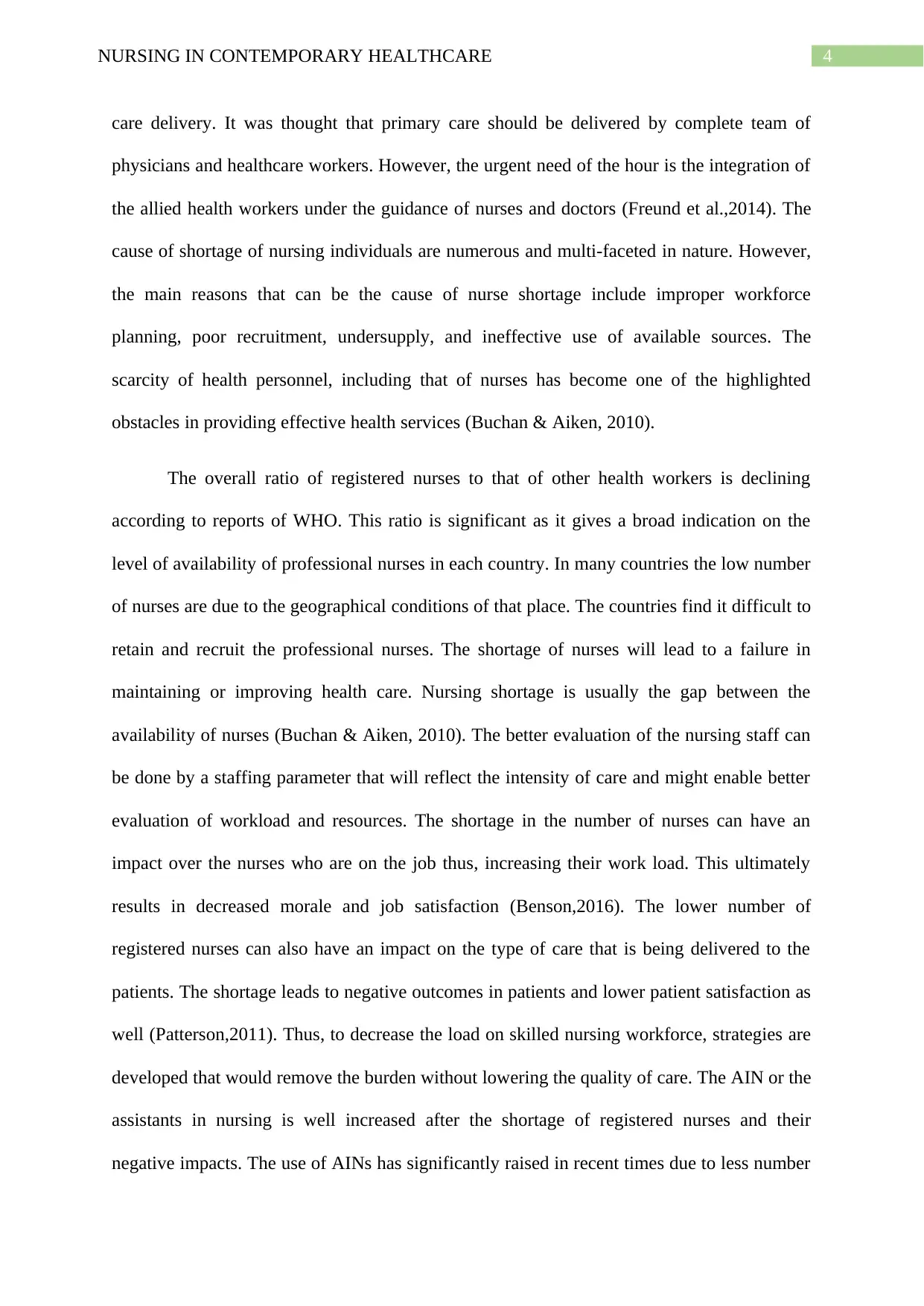
4NURSING IN CONTEMPORARY HEALTHCARE
care delivery. It was thought that primary care should be delivered by complete team of
physicians and healthcare workers. However, the urgent need of the hour is the integration of
the allied health workers under the guidance of nurses and doctors (Freund et al.,2014). The
cause of shortage of nursing individuals are numerous and multi-faceted in nature. However,
the main reasons that can be the cause of nurse shortage include improper workforce
planning, poor recruitment, undersupply, and ineffective use of available sources. The
scarcity of health personnel, including that of nurses has become one of the highlighted
obstacles in providing effective health services (Buchan & Aiken, 2010).
The overall ratio of registered nurses to that of other health workers is declining
according to reports of WHO. This ratio is significant as it gives a broad indication on the
level of availability of professional nurses in each country. In many countries the low number
of nurses are due to the geographical conditions of that place. The countries find it difficult to
retain and recruit the professional nurses. The shortage of nurses will lead to a failure in
maintaining or improving health care. Nursing shortage is usually the gap between the
availability of nurses (Buchan & Aiken, 2010). The better evaluation of the nursing staff can
be done by a staffing parameter that will reflect the intensity of care and might enable better
evaluation of workload and resources. The shortage in the number of nurses can have an
impact over the nurses who are on the job thus, increasing their work load. This ultimately
results in decreased morale and job satisfaction (Benson,2016). The lower number of
registered nurses can also have an impact on the type of care that is being delivered to the
patients. The shortage leads to negative outcomes in patients and lower patient satisfaction as
well (Patterson,2011). Thus, to decrease the load on skilled nursing workforce, strategies are
developed that would remove the burden without lowering the quality of care. The AIN or the
assistants in nursing is well increased after the shortage of registered nurses and their
negative impacts. The use of AINs has significantly raised in recent times due to less number
care delivery. It was thought that primary care should be delivered by complete team of
physicians and healthcare workers. However, the urgent need of the hour is the integration of
the allied health workers under the guidance of nurses and doctors (Freund et al.,2014). The
cause of shortage of nursing individuals are numerous and multi-faceted in nature. However,
the main reasons that can be the cause of nurse shortage include improper workforce
planning, poor recruitment, undersupply, and ineffective use of available sources. The
scarcity of health personnel, including that of nurses has become one of the highlighted
obstacles in providing effective health services (Buchan & Aiken, 2010).
The overall ratio of registered nurses to that of other health workers is declining
according to reports of WHO. This ratio is significant as it gives a broad indication on the
level of availability of professional nurses in each country. In many countries the low number
of nurses are due to the geographical conditions of that place. The countries find it difficult to
retain and recruit the professional nurses. The shortage of nurses will lead to a failure in
maintaining or improving health care. Nursing shortage is usually the gap between the
availability of nurses (Buchan & Aiken, 2010). The better evaluation of the nursing staff can
be done by a staffing parameter that will reflect the intensity of care and might enable better
evaluation of workload and resources. The shortage in the number of nurses can have an
impact over the nurses who are on the job thus, increasing their work load. This ultimately
results in decreased morale and job satisfaction (Benson,2016). The lower number of
registered nurses can also have an impact on the type of care that is being delivered to the
patients. The shortage leads to negative outcomes in patients and lower patient satisfaction as
well (Patterson,2011). Thus, to decrease the load on skilled nursing workforce, strategies are
developed that would remove the burden without lowering the quality of care. The AIN or the
assistants in nursing is well increased after the shortage of registered nurses and their
negative impacts. The use of AINs has significantly raised in recent times due to less number
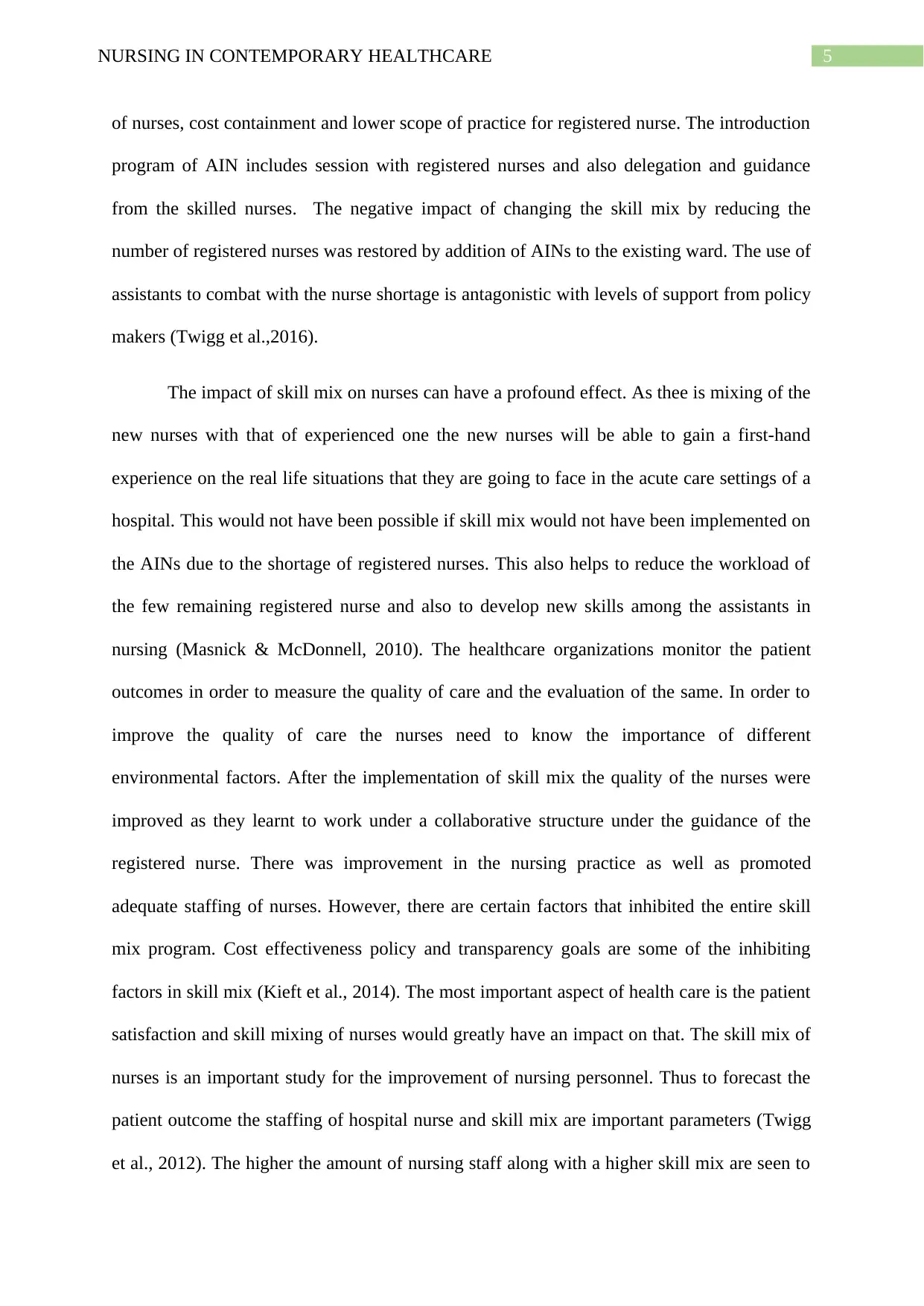
5NURSING IN CONTEMPORARY HEALTHCARE
of nurses, cost containment and lower scope of practice for registered nurse. The introduction
program of AIN includes session with registered nurses and also delegation and guidance
from the skilled nurses. The negative impact of changing the skill mix by reducing the
number of registered nurses was restored by addition of AINs to the existing ward. The use of
assistants to combat with the nurse shortage is antagonistic with levels of support from policy
makers (Twigg et al.,2016).
The impact of skill mix on nurses can have a profound effect. As thee is mixing of the
new nurses with that of experienced one the new nurses will be able to gain a first-hand
experience on the real life situations that they are going to face in the acute care settings of a
hospital. This would not have been possible if skill mix would not have been implemented on
the AINs due to the shortage of registered nurses. This also helps to reduce the workload of
the few remaining registered nurse and also to develop new skills among the assistants in
nursing (Masnick & McDonnell, 2010). The healthcare organizations monitor the patient
outcomes in order to measure the quality of care and the evaluation of the same. In order to
improve the quality of care the nurses need to know the importance of different
environmental factors. After the implementation of skill mix the quality of the nurses were
improved as they learnt to work under a collaborative structure under the guidance of the
registered nurse. There was improvement in the nursing practice as well as promoted
adequate staffing of nurses. However, there are certain factors that inhibited the entire skill
mix program. Cost effectiveness policy and transparency goals are some of the inhibiting
factors in skill mix (Kieft et al., 2014). The most important aspect of health care is the patient
satisfaction and skill mixing of nurses would greatly have an impact on that. The skill mix of
nurses is an important study for the improvement of nursing personnel. Thus to forecast the
patient outcome the staffing of hospital nurse and skill mix are important parameters (Twigg
et al., 2012). The higher the amount of nursing staff along with a higher skill mix are seen to
of nurses, cost containment and lower scope of practice for registered nurse. The introduction
program of AIN includes session with registered nurses and also delegation and guidance
from the skilled nurses. The negative impact of changing the skill mix by reducing the
number of registered nurses was restored by addition of AINs to the existing ward. The use of
assistants to combat with the nurse shortage is antagonistic with levels of support from policy
makers (Twigg et al.,2016).
The impact of skill mix on nurses can have a profound effect. As thee is mixing of the
new nurses with that of experienced one the new nurses will be able to gain a first-hand
experience on the real life situations that they are going to face in the acute care settings of a
hospital. This would not have been possible if skill mix would not have been implemented on
the AINs due to the shortage of registered nurses. This also helps to reduce the workload of
the few remaining registered nurse and also to develop new skills among the assistants in
nursing (Masnick & McDonnell, 2010). The healthcare organizations monitor the patient
outcomes in order to measure the quality of care and the evaluation of the same. In order to
improve the quality of care the nurses need to know the importance of different
environmental factors. After the implementation of skill mix the quality of the nurses were
improved as they learnt to work under a collaborative structure under the guidance of the
registered nurse. There was improvement in the nursing practice as well as promoted
adequate staffing of nurses. However, there are certain factors that inhibited the entire skill
mix program. Cost effectiveness policy and transparency goals are some of the inhibiting
factors in skill mix (Kieft et al., 2014). The most important aspect of health care is the patient
satisfaction and skill mixing of nurses would greatly have an impact on that. The skill mix of
nurses is an important study for the improvement of nursing personnel. Thus to forecast the
patient outcome the staffing of hospital nurse and skill mix are important parameters (Twigg
et al., 2012). The higher the amount of nursing staff along with a higher skill mix are seen to
⊘ This is a preview!⊘
Do you want full access?
Subscribe today to unlock all pages.

Trusted by 1+ million students worldwide
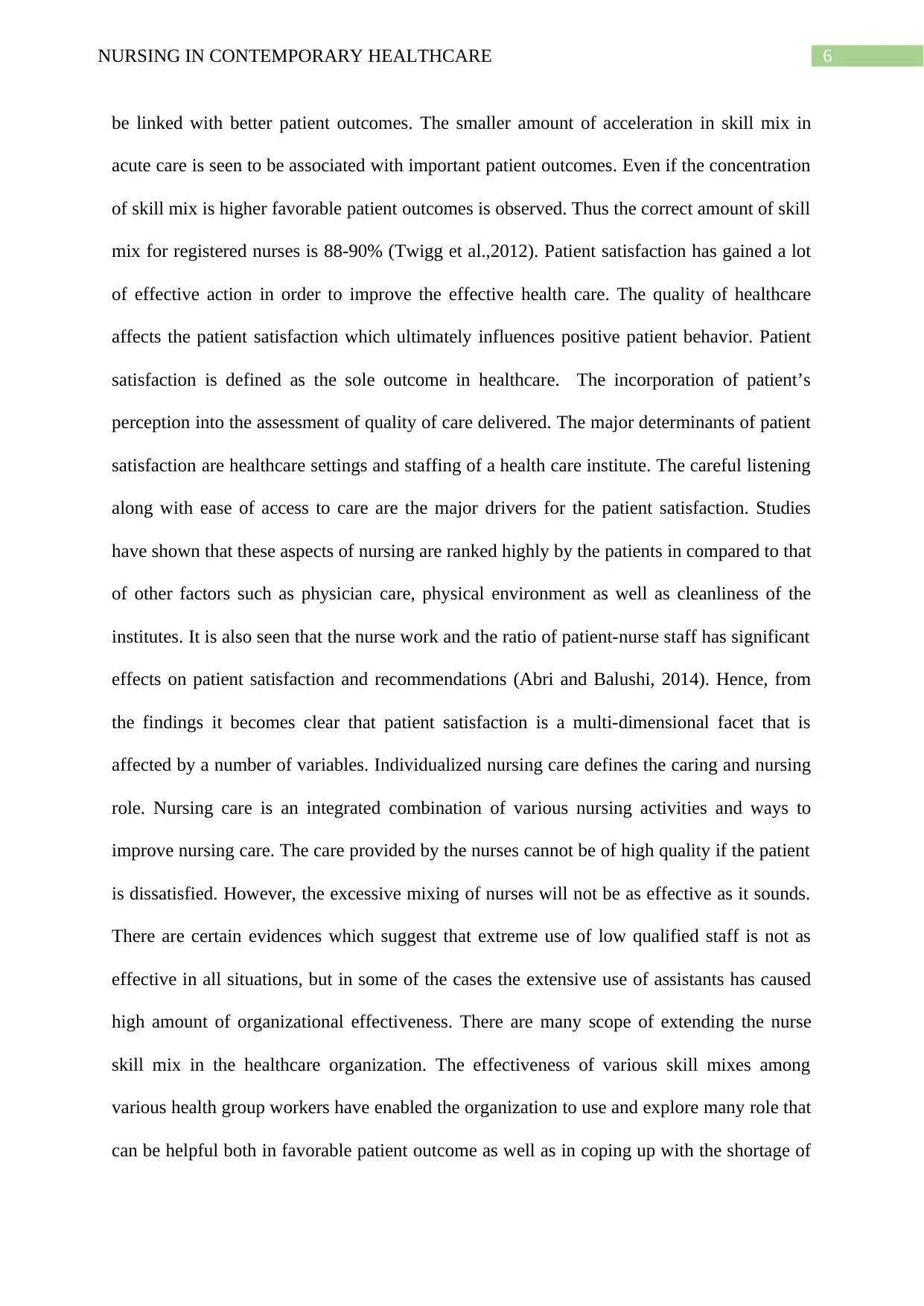
6NURSING IN CONTEMPORARY HEALTHCARE
be linked with better patient outcomes. The smaller amount of acceleration in skill mix in
acute care is seen to be associated with important patient outcomes. Even if the concentration
of skill mix is higher favorable patient outcomes is observed. Thus the correct amount of skill
mix for registered nurses is 88-90% (Twigg et al.,2012). Patient satisfaction has gained a lot
of effective action in order to improve the effective health care. The quality of healthcare
affects the patient satisfaction which ultimately influences positive patient behavior. Patient
satisfaction is defined as the sole outcome in healthcare. The incorporation of patient’s
perception into the assessment of quality of care delivered. The major determinants of patient
satisfaction are healthcare settings and staffing of a health care institute. The careful listening
along with ease of access to care are the major drivers for the patient satisfaction. Studies
have shown that these aspects of nursing are ranked highly by the patients in compared to that
of other factors such as physician care, physical environment as well as cleanliness of the
institutes. It is also seen that the nurse work and the ratio of patient-nurse staff has significant
effects on patient satisfaction and recommendations (Abri and Balushi, 2014). Hence, from
the findings it becomes clear that patient satisfaction is a multi-dimensional facet that is
affected by a number of variables. Individualized nursing care defines the caring and nursing
role. Nursing care is an integrated combination of various nursing activities and ways to
improve nursing care. The care provided by the nurses cannot be of high quality if the patient
is dissatisfied. However, the excessive mixing of nurses will not be as effective as it sounds.
There are certain evidences which suggest that extreme use of low qualified staff is not as
effective in all situations, but in some of the cases the extensive use of assistants has caused
high amount of organizational effectiveness. There are many scope of extending the nurse
skill mix in the healthcare organization. The effectiveness of various skill mixes among
various health group workers have enabled the organization to use and explore many role that
can be helpful both in favorable patient outcome as well as in coping up with the shortage of
be linked with better patient outcomes. The smaller amount of acceleration in skill mix in
acute care is seen to be associated with important patient outcomes. Even if the concentration
of skill mix is higher favorable patient outcomes is observed. Thus the correct amount of skill
mix for registered nurses is 88-90% (Twigg et al.,2012). Patient satisfaction has gained a lot
of effective action in order to improve the effective health care. The quality of healthcare
affects the patient satisfaction which ultimately influences positive patient behavior. Patient
satisfaction is defined as the sole outcome in healthcare. The incorporation of patient’s
perception into the assessment of quality of care delivered. The major determinants of patient
satisfaction are healthcare settings and staffing of a health care institute. The careful listening
along with ease of access to care are the major drivers for the patient satisfaction. Studies
have shown that these aspects of nursing are ranked highly by the patients in compared to that
of other factors such as physician care, physical environment as well as cleanliness of the
institutes. It is also seen that the nurse work and the ratio of patient-nurse staff has significant
effects on patient satisfaction and recommendations (Abri and Balushi, 2014). Hence, from
the findings it becomes clear that patient satisfaction is a multi-dimensional facet that is
affected by a number of variables. Individualized nursing care defines the caring and nursing
role. Nursing care is an integrated combination of various nursing activities and ways to
improve nursing care. The care provided by the nurses cannot be of high quality if the patient
is dissatisfied. However, the excessive mixing of nurses will not be as effective as it sounds.
There are certain evidences which suggest that extreme use of low qualified staff is not as
effective in all situations, but in some of the cases the extensive use of assistants has caused
high amount of organizational effectiveness. There are many scope of extending the nurse
skill mix in the healthcare organization. The effectiveness of various skill mixes among
various health group workers have enabled the organization to use and explore many role that
can be helpful both in favorable patient outcome as well as in coping up with the shortage of
Paraphrase This Document
Need a fresh take? Get an instant paraphrase of this document with our AI Paraphraser
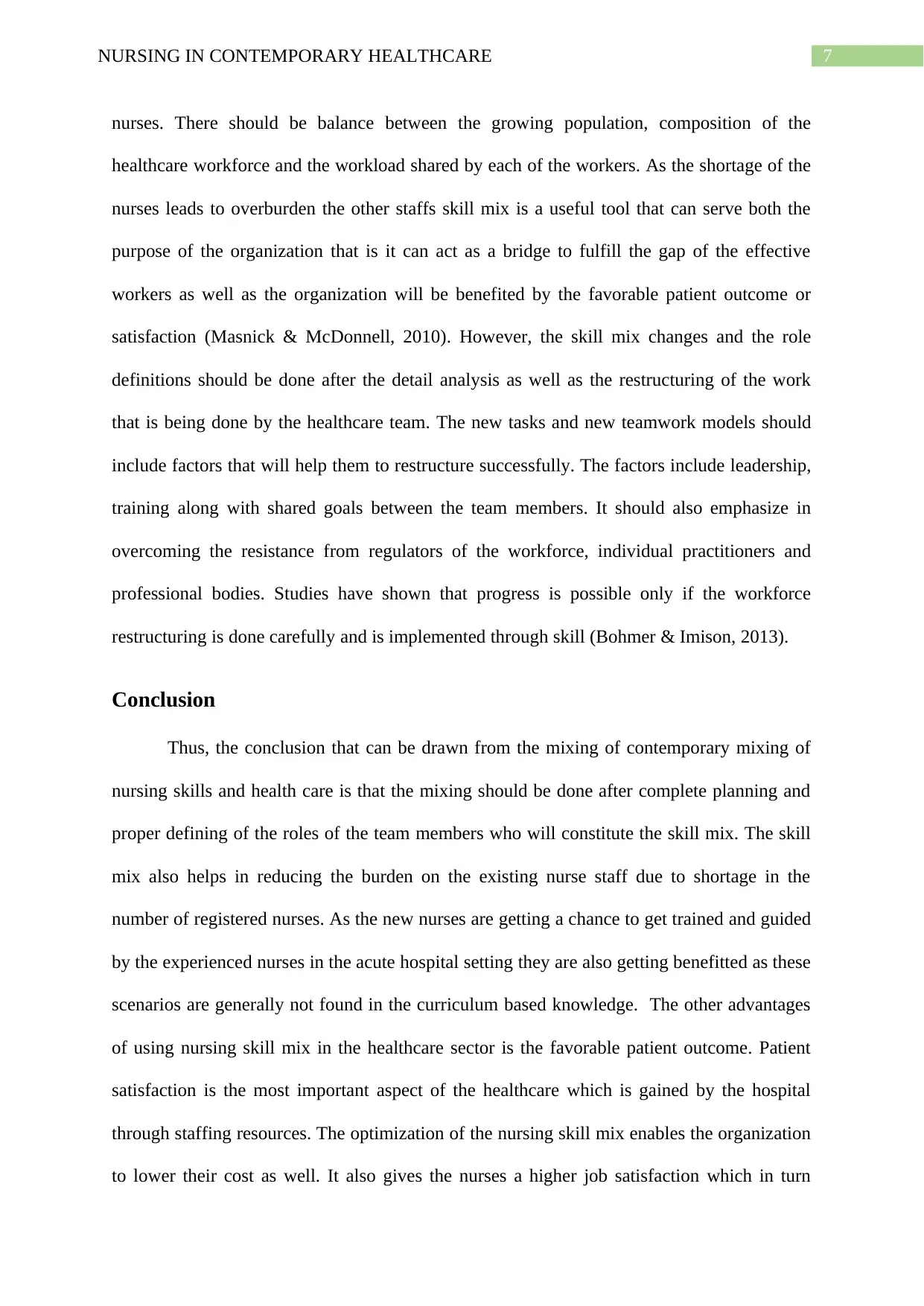
7NURSING IN CONTEMPORARY HEALTHCARE
nurses. There should be balance between the growing population, composition of the
healthcare workforce and the workload shared by each of the workers. As the shortage of the
nurses leads to overburden the other staffs skill mix is a useful tool that can serve both the
purpose of the organization that is it can act as a bridge to fulfill the gap of the effective
workers as well as the organization will be benefited by the favorable patient outcome or
satisfaction (Masnick & McDonnell, 2010). However, the skill mix changes and the role
definitions should be done after the detail analysis as well as the restructuring of the work
that is being done by the healthcare team. The new tasks and new teamwork models should
include factors that will help them to restructure successfully. The factors include leadership,
training along with shared goals between the team members. It should also emphasize in
overcoming the resistance from regulators of the workforce, individual practitioners and
professional bodies. Studies have shown that progress is possible only if the workforce
restructuring is done carefully and is implemented through skill (Bohmer & Imison, 2013).
Conclusion
Thus, the conclusion that can be drawn from the mixing of contemporary mixing of
nursing skills and health care is that the mixing should be done after complete planning and
proper defining of the roles of the team members who will constitute the skill mix. The skill
mix also helps in reducing the burden on the existing nurse staff due to shortage in the
number of registered nurses. As the new nurses are getting a chance to get trained and guided
by the experienced nurses in the acute hospital setting they are also getting benefitted as these
scenarios are generally not found in the curriculum based knowledge. The other advantages
of using nursing skill mix in the healthcare sector is the favorable patient outcome. Patient
satisfaction is the most important aspect of the healthcare which is gained by the hospital
through staffing resources. The optimization of the nursing skill mix enables the organization
to lower their cost as well. It also gives the nurses a higher job satisfaction which in turn
nurses. There should be balance between the growing population, composition of the
healthcare workforce and the workload shared by each of the workers. As the shortage of the
nurses leads to overburden the other staffs skill mix is a useful tool that can serve both the
purpose of the organization that is it can act as a bridge to fulfill the gap of the effective
workers as well as the organization will be benefited by the favorable patient outcome or
satisfaction (Masnick & McDonnell, 2010). However, the skill mix changes and the role
definitions should be done after the detail analysis as well as the restructuring of the work
that is being done by the healthcare team. The new tasks and new teamwork models should
include factors that will help them to restructure successfully. The factors include leadership,
training along with shared goals between the team members. It should also emphasize in
overcoming the resistance from regulators of the workforce, individual practitioners and
professional bodies. Studies have shown that progress is possible only if the workforce
restructuring is done carefully and is implemented through skill (Bohmer & Imison, 2013).
Conclusion
Thus, the conclusion that can be drawn from the mixing of contemporary mixing of
nursing skills and health care is that the mixing should be done after complete planning and
proper defining of the roles of the team members who will constitute the skill mix. The skill
mix also helps in reducing the burden on the existing nurse staff due to shortage in the
number of registered nurses. As the new nurses are getting a chance to get trained and guided
by the experienced nurses in the acute hospital setting they are also getting benefitted as these
scenarios are generally not found in the curriculum based knowledge. The other advantages
of using nursing skill mix in the healthcare sector is the favorable patient outcome. Patient
satisfaction is the most important aspect of the healthcare which is gained by the hospital
through staffing resources. The optimization of the nursing skill mix enables the organization
to lower their cost as well. It also gives the nurses a higher job satisfaction which in turn
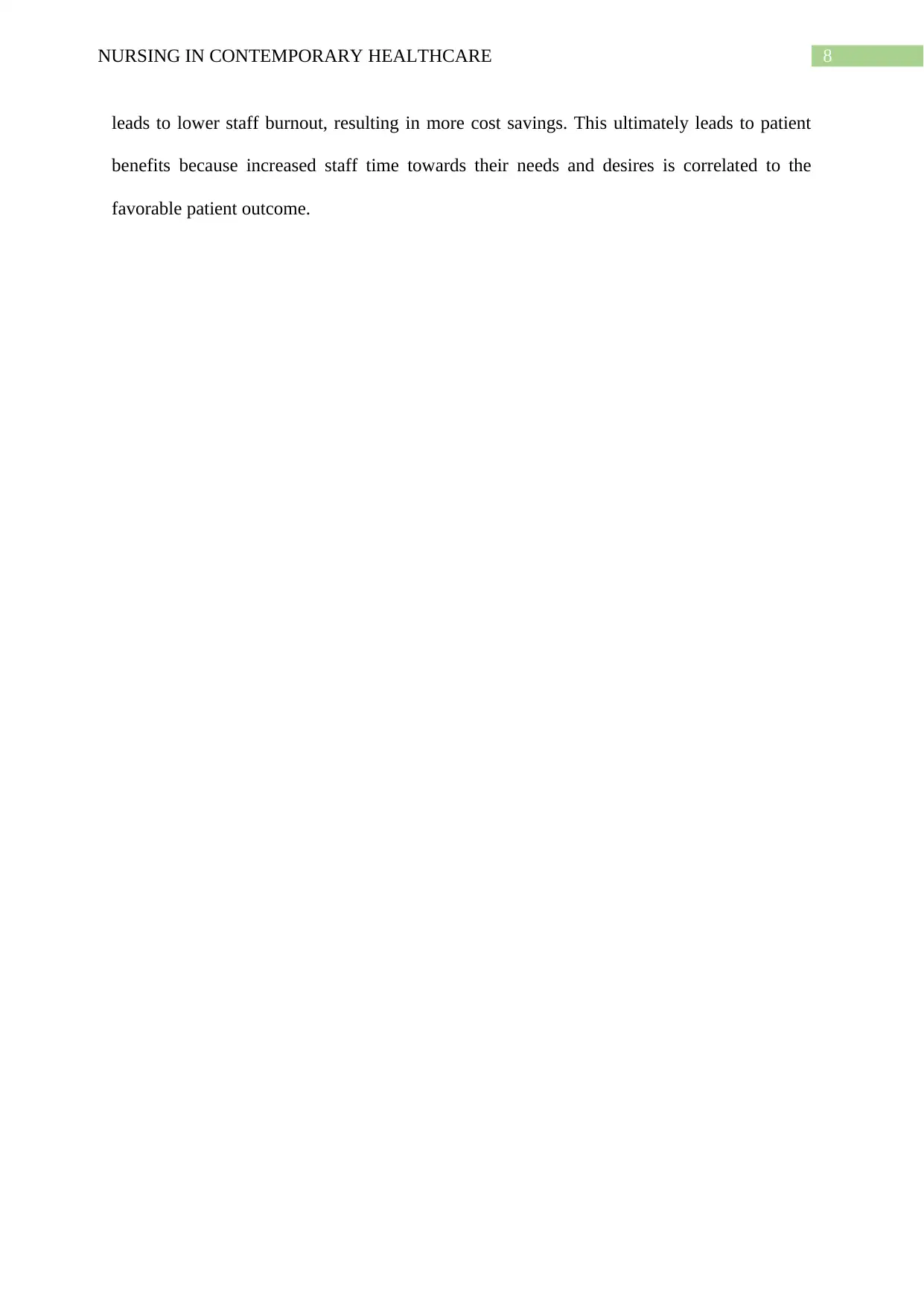
8NURSING IN CONTEMPORARY HEALTHCARE
leads to lower staff burnout, resulting in more cost savings. This ultimately leads to patient
benefits because increased staff time towards their needs and desires is correlated to the
favorable patient outcome.
leads to lower staff burnout, resulting in more cost savings. This ultimately leads to patient
benefits because increased staff time towards their needs and desires is correlated to the
favorable patient outcome.
⊘ This is a preview!⊘
Do you want full access?
Subscribe today to unlock all pages.

Trusted by 1+ million students worldwide
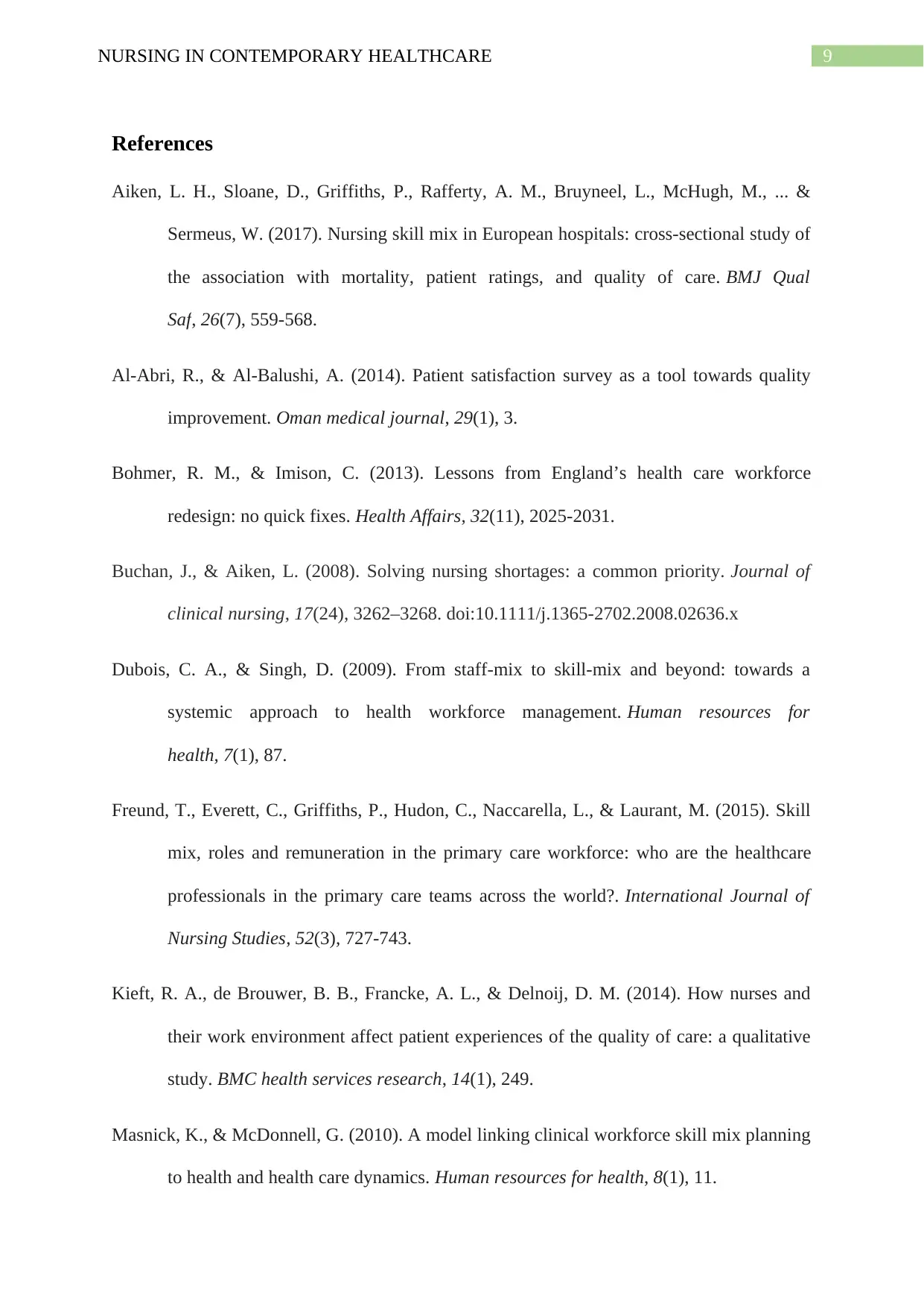
9NURSING IN CONTEMPORARY HEALTHCARE
References
Aiken, L. H., Sloane, D., Griffiths, P., Rafferty, A. M., Bruyneel, L., McHugh, M., ... &
Sermeus, W. (2017). Nursing skill mix in European hospitals: cross-sectional study of
the association with mortality, patient ratings, and quality of care. BMJ Qual
Saf, 26(7), 559-568.
Al-Abri, R., & Al-Balushi, A. (2014). Patient satisfaction survey as a tool towards quality
improvement. Oman medical journal, 29(1), 3.
Bohmer, R. M., & Imison, C. (2013). Lessons from England’s health care workforce
redesign: no quick fixes. Health Affairs, 32(11), 2025-2031.
Buchan, J., & Aiken, L. (2008). Solving nursing shortages: a common priority. Journal of
clinical nursing, 17(24), 3262–3268. doi:10.1111/j.1365-2702.2008.02636.x
Dubois, C. A., & Singh, D. (2009). From staff-mix to skill-mix and beyond: towards a
systemic approach to health workforce management. Human resources for
health, 7(1), 87.
Freund, T., Everett, C., Griffiths, P., Hudon, C., Naccarella, L., & Laurant, M. (2015). Skill
mix, roles and remuneration in the primary care workforce: who are the healthcare
professionals in the primary care teams across the world?. International Journal of
Nursing Studies, 52(3), 727-743.
Kieft, R. A., de Brouwer, B. B., Francke, A. L., & Delnoij, D. M. (2014). How nurses and
their work environment affect patient experiences of the quality of care: a qualitative
study. BMC health services research, 14(1), 249.
Masnick, K., & McDonnell, G. (2010). A model linking clinical workforce skill mix planning
to health and health care dynamics. Human resources for health, 8(1), 11.
References
Aiken, L. H., Sloane, D., Griffiths, P., Rafferty, A. M., Bruyneel, L., McHugh, M., ... &
Sermeus, W. (2017). Nursing skill mix in European hospitals: cross-sectional study of
the association with mortality, patient ratings, and quality of care. BMJ Qual
Saf, 26(7), 559-568.
Al-Abri, R., & Al-Balushi, A. (2014). Patient satisfaction survey as a tool towards quality
improvement. Oman medical journal, 29(1), 3.
Bohmer, R. M., & Imison, C. (2013). Lessons from England’s health care workforce
redesign: no quick fixes. Health Affairs, 32(11), 2025-2031.
Buchan, J., & Aiken, L. (2008). Solving nursing shortages: a common priority. Journal of
clinical nursing, 17(24), 3262–3268. doi:10.1111/j.1365-2702.2008.02636.x
Dubois, C. A., & Singh, D. (2009). From staff-mix to skill-mix and beyond: towards a
systemic approach to health workforce management. Human resources for
health, 7(1), 87.
Freund, T., Everett, C., Griffiths, P., Hudon, C., Naccarella, L., & Laurant, M. (2015). Skill
mix, roles and remuneration in the primary care workforce: who are the healthcare
professionals in the primary care teams across the world?. International Journal of
Nursing Studies, 52(3), 727-743.
Kieft, R. A., de Brouwer, B. B., Francke, A. L., & Delnoij, D. M. (2014). How nurses and
their work environment affect patient experiences of the quality of care: a qualitative
study. BMC health services research, 14(1), 249.
Masnick, K., & McDonnell, G. (2010). A model linking clinical workforce skill mix planning
to health and health care dynamics. Human resources for health, 8(1), 11.
Paraphrase This Document
Need a fresh take? Get an instant paraphrase of this document with our AI Paraphraser
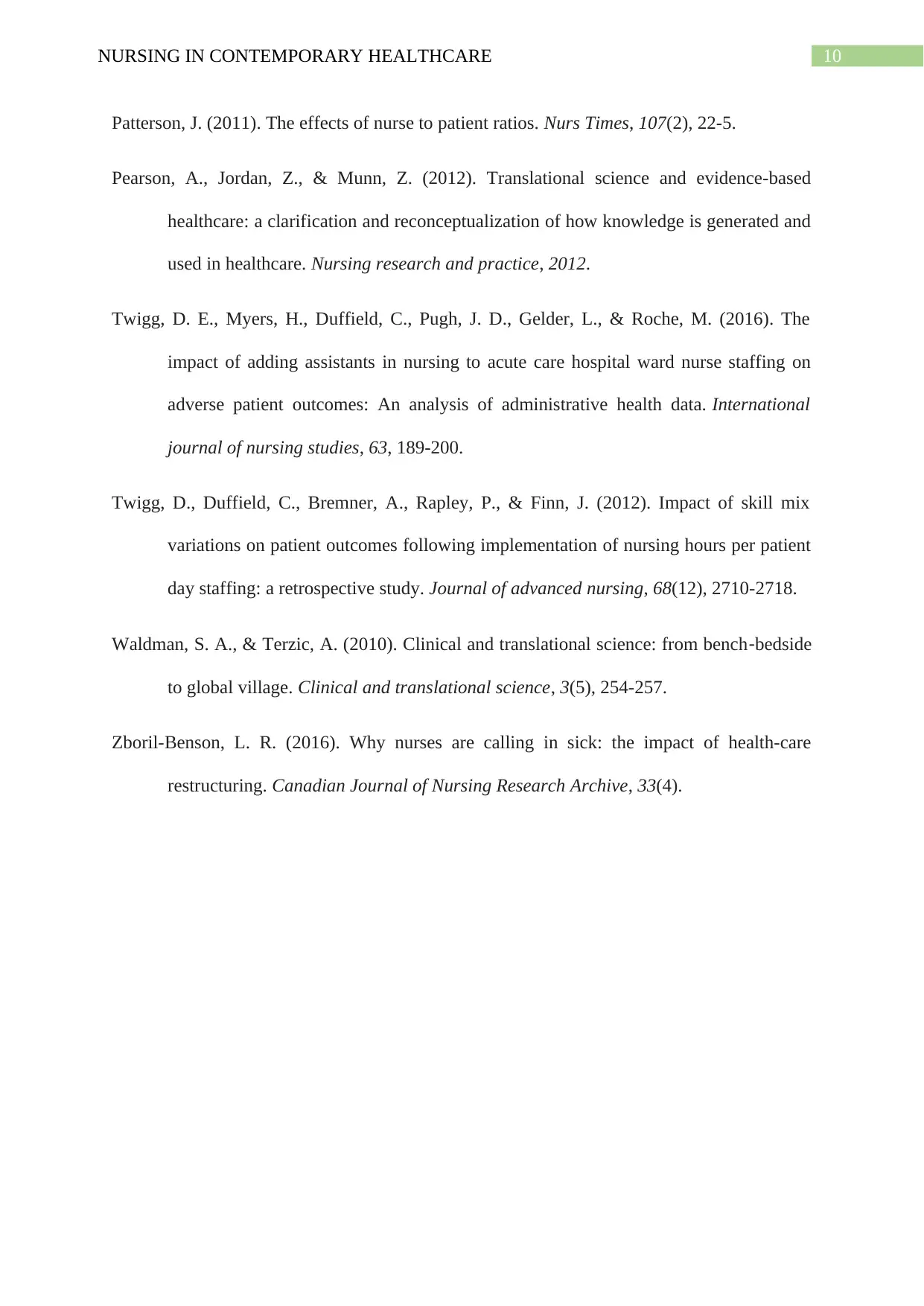
10NURSING IN CONTEMPORARY HEALTHCARE
Patterson, J. (2011). The effects of nurse to patient ratios. Nurs Times, 107(2), 22-5.
Pearson, A., Jordan, Z., & Munn, Z. (2012). Translational science and evidence-based
healthcare: a clarification and reconceptualization of how knowledge is generated and
used in healthcare. Nursing research and practice, 2012.
Twigg, D. E., Myers, H., Duffield, C., Pugh, J. D., Gelder, L., & Roche, M. (2016). The
impact of adding assistants in nursing to acute care hospital ward nurse staffing on
adverse patient outcomes: An analysis of administrative health data. International
journal of nursing studies, 63, 189-200.
Twigg, D., Duffield, C., Bremner, A., Rapley, P., & Finn, J. (2012). Impact of skill mix
variations on patient outcomes following implementation of nursing hours per patient
day staffing: a retrospective study. Journal of advanced nursing, 68(12), 2710-2718.
Waldman, S. A., & Terzic, A. (2010). Clinical and translational science: from bench‐bedside
to global village. Clinical and translational science, 3(5), 254-257.
Zboril-Benson, L. R. (2016). Why nurses are calling in sick: the impact of health-care
restructuring. Canadian Journal of Nursing Research Archive, 33(4).
Patterson, J. (2011). The effects of nurse to patient ratios. Nurs Times, 107(2), 22-5.
Pearson, A., Jordan, Z., & Munn, Z. (2012). Translational science and evidence-based
healthcare: a clarification and reconceptualization of how knowledge is generated and
used in healthcare. Nursing research and practice, 2012.
Twigg, D. E., Myers, H., Duffield, C., Pugh, J. D., Gelder, L., & Roche, M. (2016). The
impact of adding assistants in nursing to acute care hospital ward nurse staffing on
adverse patient outcomes: An analysis of administrative health data. International
journal of nursing studies, 63, 189-200.
Twigg, D., Duffield, C., Bremner, A., Rapley, P., & Finn, J. (2012). Impact of skill mix
variations on patient outcomes following implementation of nursing hours per patient
day staffing: a retrospective study. Journal of advanced nursing, 68(12), 2710-2718.
Waldman, S. A., & Terzic, A. (2010). Clinical and translational science: from bench‐bedside
to global village. Clinical and translational science, 3(5), 254-257.
Zboril-Benson, L. R. (2016). Why nurses are calling in sick: the impact of health-care
restructuring. Canadian Journal of Nursing Research Archive, 33(4).
1 out of 11
Related Documents
Your All-in-One AI-Powered Toolkit for Academic Success.
+13062052269
info@desklib.com
Available 24*7 on WhatsApp / Email
![[object Object]](/_next/static/media/star-bottom.7253800d.svg)
Unlock your academic potential
Copyright © 2020–2025 A2Z Services. All Rights Reserved. Developed and managed by ZUCOL.




